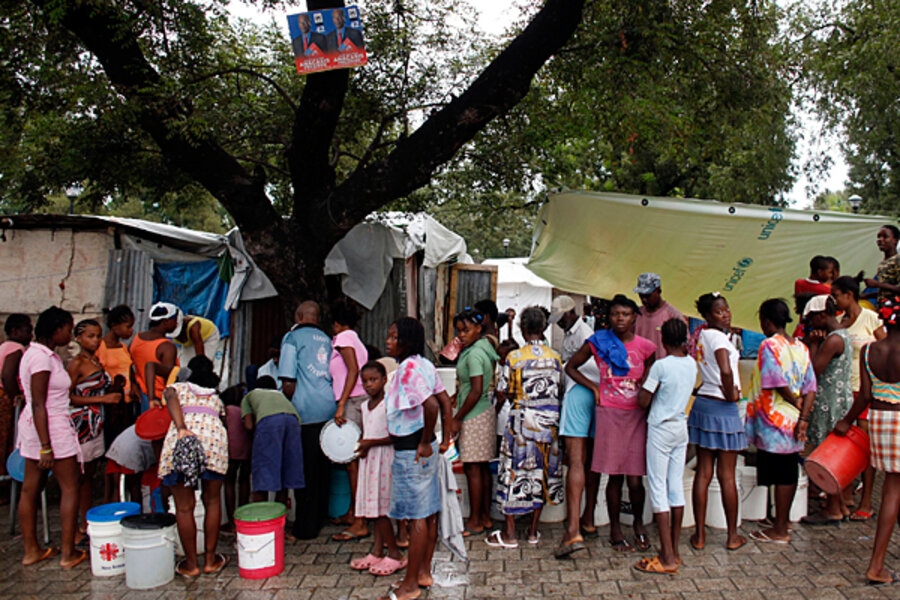Storm Tomas and cholera outbreak add urgency to Haiti's sanitation problems
Loading...
| Port-au-Prince, Haiti
Even without a hurricane, sanitation in Haiti's capital is poor, local water sources are contaminated, and the 4 kilometer road to the shantytown of Cite Soleil is knee deep with mud and raw sewage.
“It's always like this,” says Lionel Elve, a university student while driving his moped along the road. “The rains sweep the filthy streets from Petionville to Cite Soleil and clog the canals with trash flowing down to sea.”
Now, earthquake-devastated Port-au-Prince is bracing for tropical storm Tomas to hit Friday – potentially the first direct hurricane landing in a century. Tomas comes two weeks after cholera broke out, killing more than 440 people, infecting thousands of others, and looming over the millions of Haitians living in shantytowns like Cite Soleil and in tent cities across the capital.
Tomas was 295 miles southwest of Port-au-Prince as of 2 pm Thursday, according to the National Hurricane Center in Miami, which is forecasting that the tropical storm will increase in intensity and possibly become a hurricane by the time it makes landfall.
Amid the potential for three simultaneous humanitarian catastrophes – an earthquake, a hurricane, and a cholera outbreak – the capital also faces severe sanitation problems, particularly around Cite Soleil, home to some 400,000 people and one of the capital's few sewage dumping points.
Apocalyptic landscape
Thousands of adults and children forage for recyclables at the dump known as Troutier, an apocalyptic landscape of open pits of raw sewage and piles of smoldering trash. Local residents, fed up with the never-ending line of sewage trucks, briefly blockaded the entrance to the dump on Oct. 27.
The blockade lasted mere hours, but it highlighted the dump's importance – as long as the blockade lasted, the sewage trucks could not empty their waste or collect more sewage from the tent cities around the capital.
Gardy Guerrier, one of the protest organizers, says Troutier has grown over the years. Land that once yielded bananas, melons, peas, and vegetables is now infested with mosquitoes and rats.
"The stench in the air is so disagreeable it's impossible to breathe," says Mr. Guerrier. The dumping of sewage at Troutier only began in December 2009, he adds. The government said the measure was temporary, he says, but it has continued for nearly a year, contaminating all the shallow drinking wells in the area. Locals rely on water shipped in. Water vending trucks parade the streets like ice cream trucks, playing a jingly rendition of the “Titanic” theme song.
'They need another site'
Between 500 and 900 cubic meters of raw sewage is dumped daily at Troutier, according to Theo Huitema, World Vision's water and sanitation expert. He disagrees that the sewage is necessarily contaminating the local water supply, though he says that it would be better to dump it further outside the city.
But Sasha Kramer of SOIL, an NGO that has constructed dry compost toilets in Haiti since 2004, says the decision to unload human waste into the city's garbage dump at Troutier was disastrous. "They need to close off Troutier, put a fence around the pits, and have patrols out there monitoring and cleaning,” she says.
“Ultimately, they need another site,” she continues, but land ownership issues “have halted this process as no landowners want to host the city's raw sewage, especially now with a cholera epidemic at hand.”
Lack of access to clean water
The poor sanitation seen at Cite Soleil is repeated across Port-au-Prince. An estimated 1.3 million people live in some 1,300 tent cities here, but only 70 percent of them have access to water, and much of this is not potable, according to Mark Schuller, a professor at the City University of New York who led an extensive survey on camp conditions this past summer. Only 60 percent of camps have properly serviced toilets, he says.
On Oct. 26, Nigel Fisher, the UN Deputy Special Envoy for Haiti, told CBC Radio One that "the great majority" of internally displaced camps are being served with potable water and sanitation services.
The Interim Commission for the Reconstruction of Haiti approved $115 million in mid-August to "expand the water and sanitation network in Port-au-Prince and create additional coverage." IHRC press officer Denis Dufrene said she didn't know if the money has arrived yet.





